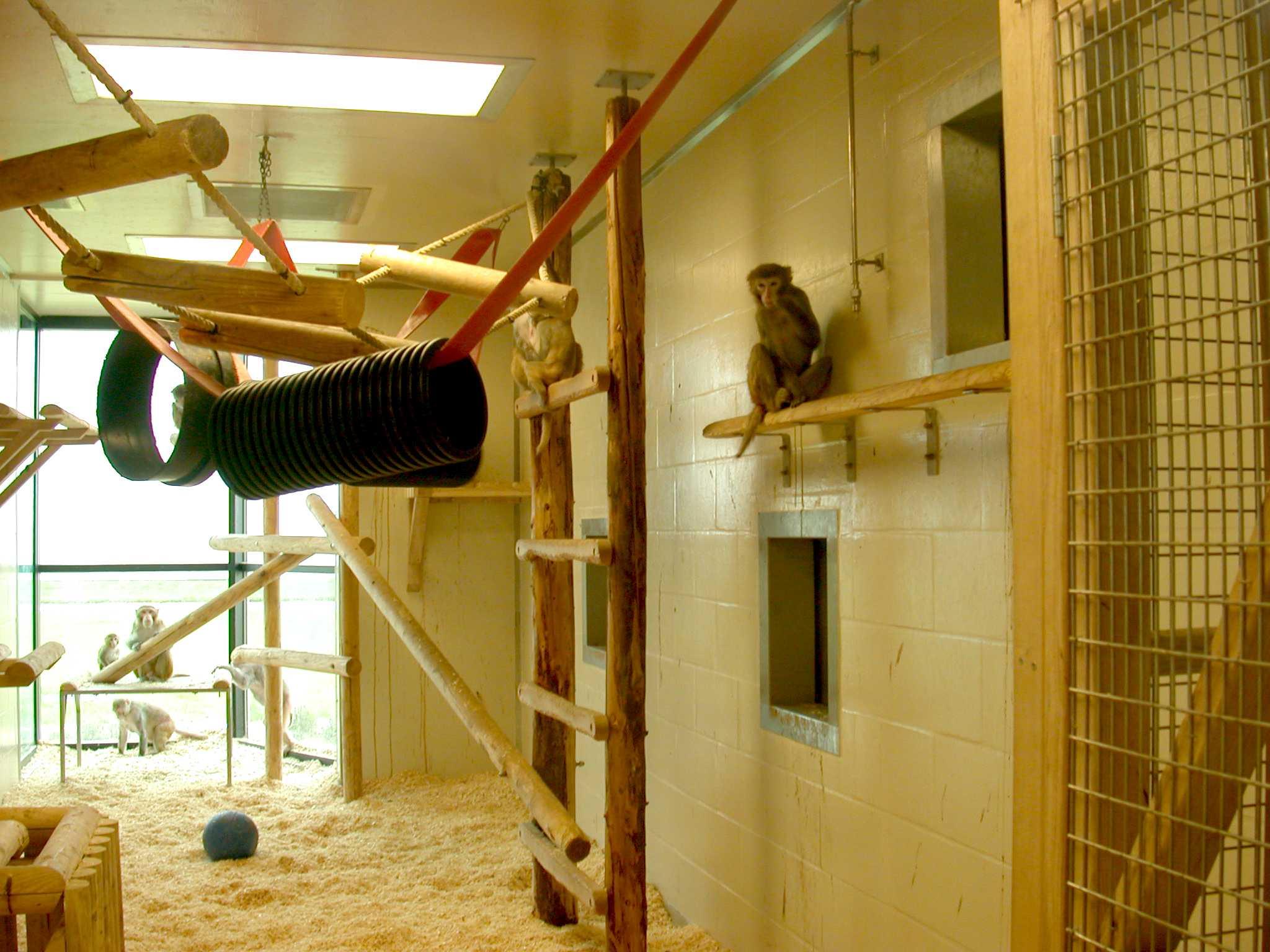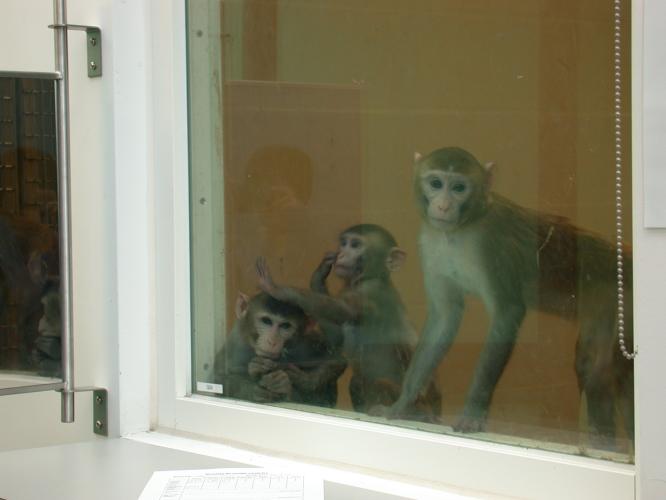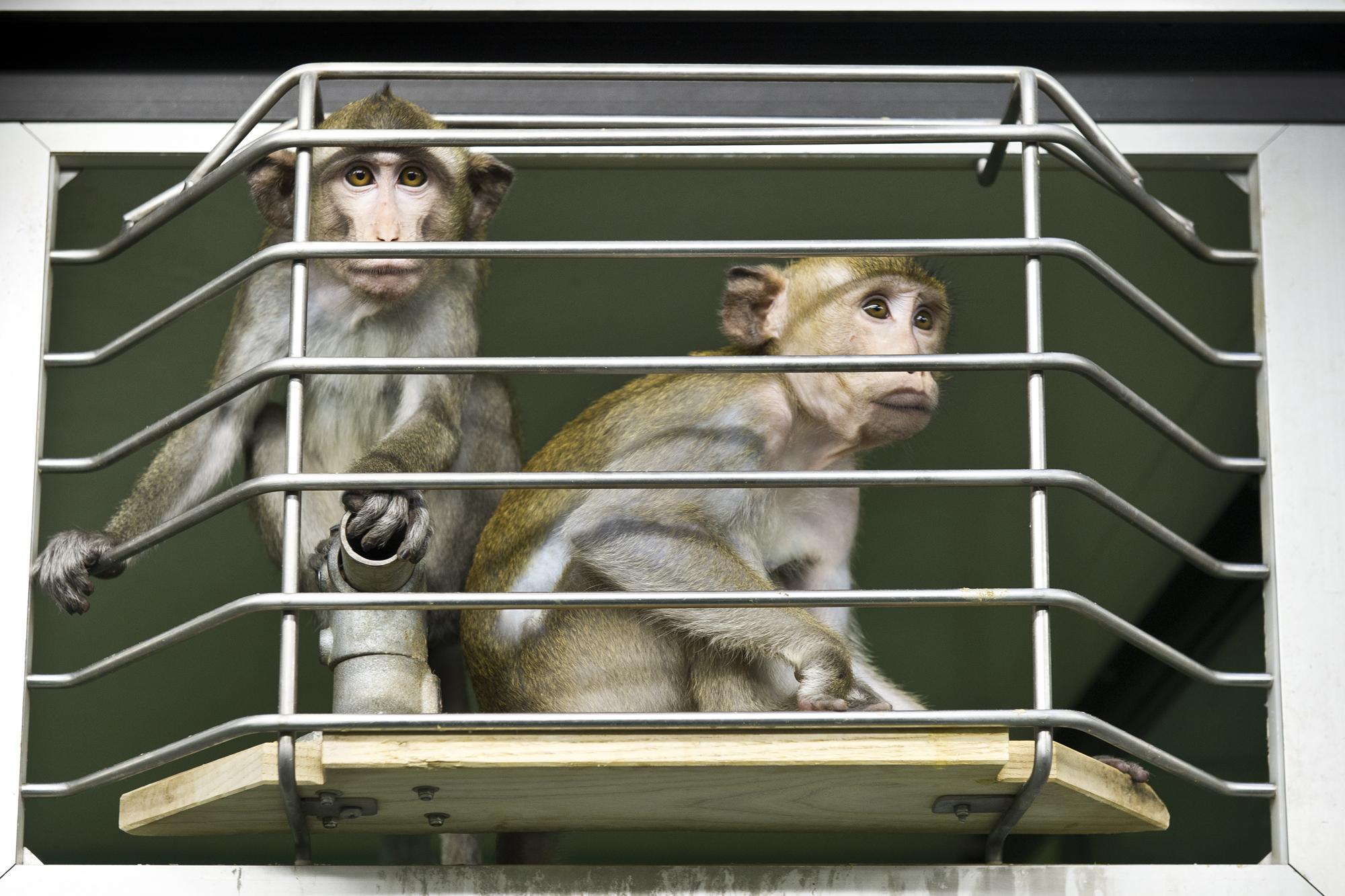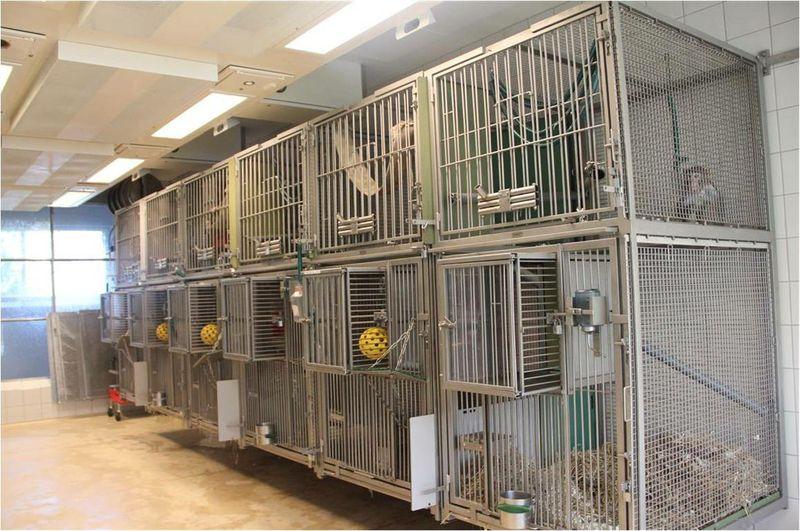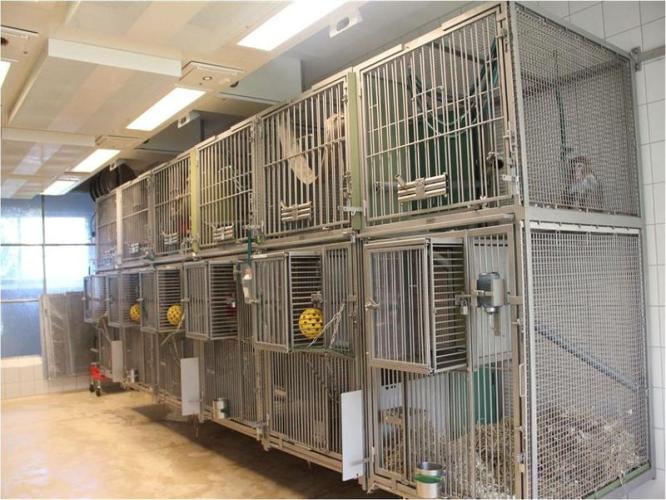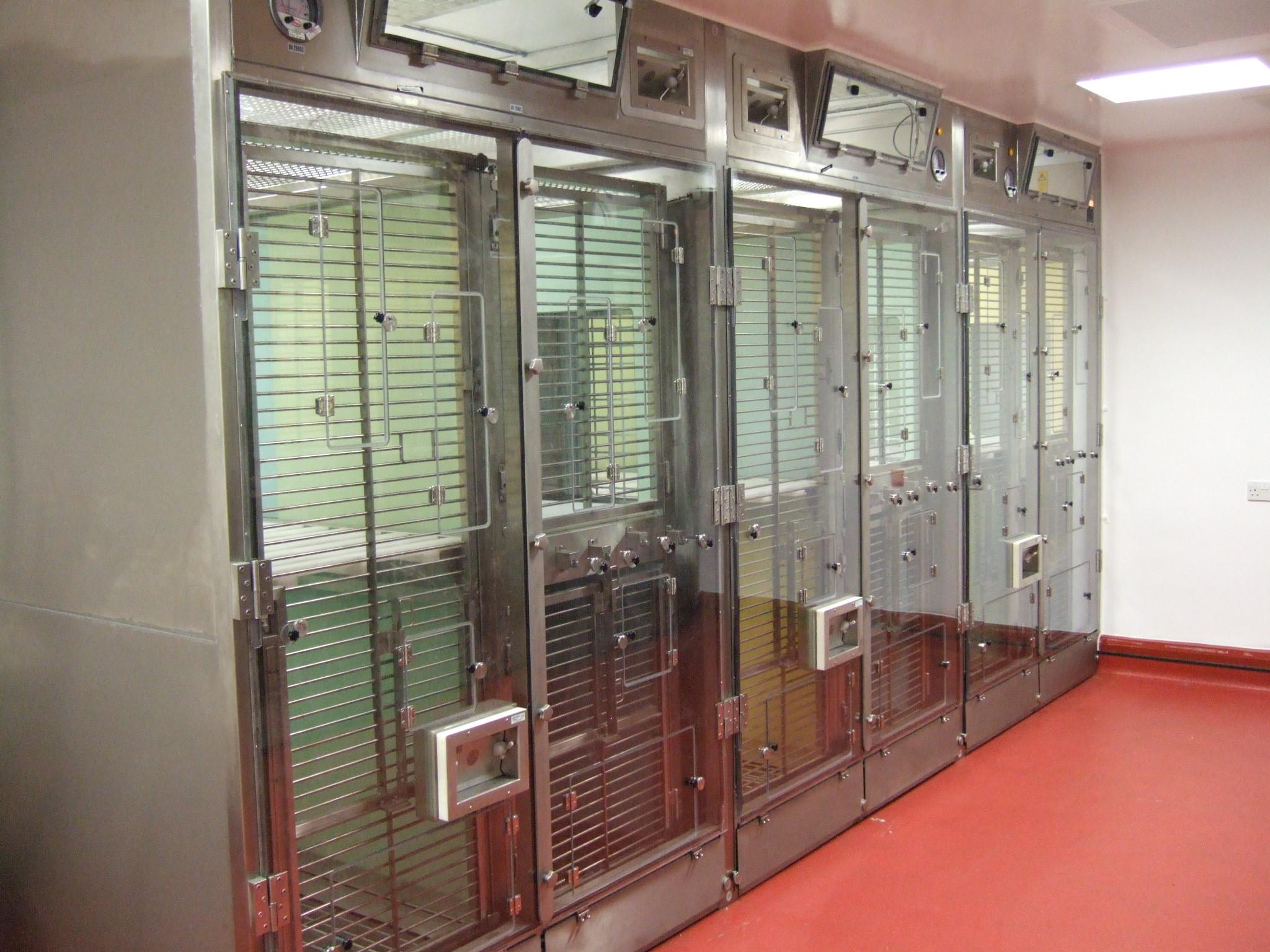Social housing in large, enriched enclosures can save time, space and money:
- Reduces time spent making and distributing individual enrichment devices.
- Reduces time spent filling food hoppers and cleaning waste, as food may be scattered across the group enclosure in one go.
- Organic waste may be left to decompose naturally or be washed or swept away.
- Enables frequent and quick health monitoring by scanning the behaviour of the social group.
- Healthy animals are easier to train and will be more cooperative in training and handling for husbandry, research and other scientific procedures.
- Healthy animals require fewer veterinary interventions with associated cost reductions in veterinarian fees and medication.
- DIY social housing systems can be much cheaper, and more space-efficient, than traditional metal caging systems.
Housing design also needs to allow staff to perform husbandry, animal handling and scientific procedures safely and with minimum disruption.
Aspects of best practice
- Social housing in large, stable social groups with visual and auditory access to neighbouring groups allows performance of a full range of natural behaviours.
- A grassed outdoor area with indoor shelter is cheaper and less time consuming to construct and maintain than solid housing.
- A large area with visual barriers and climbing structures at vertical, horizontal and diagonal angles provides choice and complexity, opportunity for physical exercise and room to avoid, flee or hide from dominant animals.
- High, wide, perches allow animals to view inside and outside of the enclosure [6,7].
- Grass into which seeds and grains may be thrown to provide foraging opportunities, The corral also contains naturally occurring herbs, other plants and invertebrates. Macaques housed in outdoor pens with grass substrate spend more time foraging and less time fighting than macaques housed in outdoor pens with gravel substrate [8,9].
- Soft ground causes less wear and tear on joints than does concrete or gravel.
- Natural sunlight enhances vitamin D levels and bone strength.
- Areas of shade and indoor areas allow animals to regulate their body temperature by avoiding extremes of weather. Macaques spend a significant proportion of their day basking in the sun and resting in the shade [10,11].
- Less staff time is spent cleaning organic waste matter or distributing enrichment devices as animals can express naturalistic time budgets, foraging resting, grooming and locomoting.
- Suitable enrichments for group housed animals are relatively cheap, quick and easy to provide.
- Spreading odours around the enclosure, including less visited areas, encourages exploratory and locomotory behaviour.
- Socially housed animals provide research opportunities for scientific programmes incorporating social aspects.
-
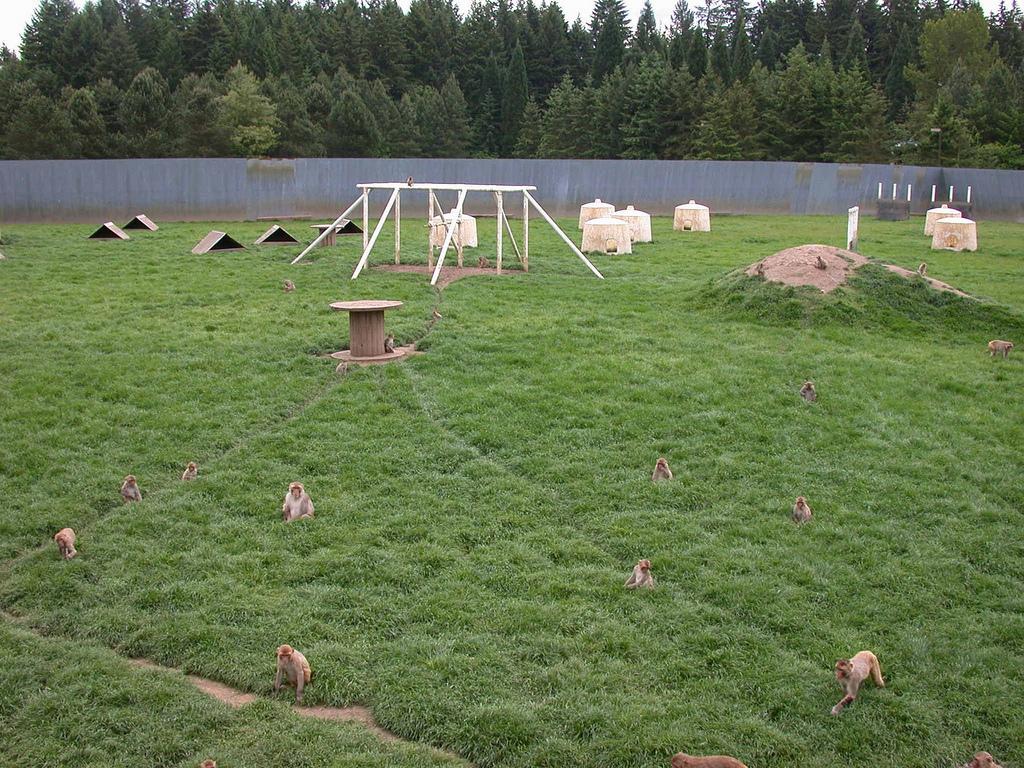 Outdoor corrals best practice. Here, monkeys are housed in very large and complex social groups with grassy areas to forage, and wooden structures to climb. This is the best type of captive housing to promote positive welfare.
Outdoor corrals best practice. Here, monkeys are housed in very large and complex social groups with grassy areas to forage, and wooden structures to climb. This is the best type of captive housing to promote positive welfare.
Considerations
- Enclosure structures must provide complex climbing and other locomotory opportunities, be sturdy, well built and maintained regularly.
- Where possible, enclosure furniture should be made from organic ‘warm’ materials, such as wood [2].
- Fencing must be storm-proof and there must be no opportunity for escape.
- There must be multiple areas where animals may seek warmth, or cool down, so that all animals may regulate their body temperature.
- Valued resources should be spread out around the enclosure, so that subordinates can gain access.
-
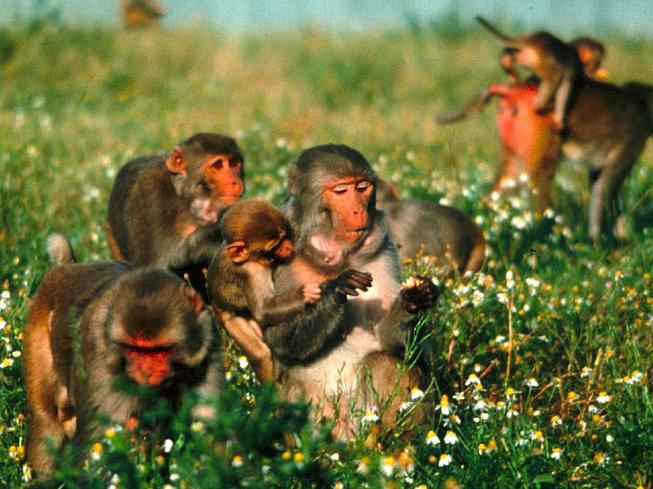 Rhesus macaques feeding on herbs in an open corral
Rhesus macaques feeding on herbs in an open corral
Perceived problems and how to overcome them
Good habituation and socialization to humans can overcome such problems.
Macaques respond positively to well-structured routines. Having clear signals for animals to return to the indoor area, where capture and handling can be conducted more easily, means they can be managed routinely and effectively. Using a clear signal associated with food reward delivery in the indoor area allows flexibility in the timing of procedures, and prevents anticipatory stress responses associated with feeding and procedures occurring at set times of day.
The two-tiered housing above has a wooden slatted floor between the two levels, increasing the available surface area and creating an additional visual barrier. The fencing and roofing provide climbing structures in addition to the vertical, horizontal and diagonal structures/perches inside. There are multiple access points (‘pop holes’) between the two levels to prevent dominant animals from monopolising them, and ladders, steps and platforms to aid young and geriatric animals to reach them. For more information, see Waitt et al. 2008.
Aspects of best practice
- Social housing in medium- to large-sized, stable social groups with visual and auditory access to neighbouring groups allows performance of a full range of natural behaviours.
- Visual barriers and climbing structures at vertical, horizontal and diagonal angles provides choice and complexity, opportunity for physical exercise and room to avoid, flee or hide from dominant animals.
- Multiple access points enable all animals to access resources such as feeders, water spouts and resting areas.
- Less staff time is needed for making and distributing enrichment devices. Suitable enrichments for group housed animals are cheap, quick and easy to provide.
- Scattered foods encourage exploratory and foraging behaviours.
- Natural sunlight and fresh air reach the lower level due to the mesh sides and slatted floor.
- Areas of shade allow animals to regulate their body temperature by avoiding extremes of weather. Macaques spend a significant proportion of their day basking in the sun and resting in the shade [10,11].
- Socially housed animals provide research opportunities for scientific programmes incorporating social aspects.
Considerations
- The outer fittings as well as the internal substrates and environmental enrichment should be sturdy and well-constructed, as the macaques are likely to bounce off the mesh as well as shake it and try to pry joined pieces apart.
- Mesh must be sturdy and well maintained. Sand down sharp edges and fix loose connections and broken wires immediately.
- Wherever possible use softer natural materials such as wood. Metal caging is noisy, which can cause stress for both animals and staff.
- Staff must add and remove foraging substrate and organic waste matter from the floor.
- Concrete flooring is hard on the animals’ joints.
- Avoid drainage systems which could become easily clogged.
Perceived problems and how to overcome them
Good habituation and socialization to humans can overcome such problems.
| Macaques respond positively to well-structured routines. Having clear signals for the animals to move to a certain part of the enclosure, where capture and handling can be conducted more easily, means they can be managed routinely and effectively. Using a clear signal associated with food reward delivery in the capture area allows flexibility in the timing of procedures, and prevents anticipatory stress responses associated with feeding and procedures occurring at set times of day. |
The image above shows a complex and stimulating space, large enough for macaques to run, climb, swing, jump, flee upwards and hide from dominant animals or humans (Credit: MRC Centre for Macaques).
Aspects of best practice
- Social housing in medium-sized, stable social groups with visual and auditory access to neighbouring groups allows a range of natural behaviours.
- Visual barriers and varied climbing structures and perches provide choice and complexity.
- Multiple resources such as feeders, water spouts and resting areas are provided to allow all animals to gain access and prevent dominant animals from monopolising them.
- Natural sunlight enters through large floor-to-ceiling windows, promoting health and well-being. The animals spend large portions of their day resting in the sunshine.
- One-way tinted glass can be used to allow the animals to observe outside activity with little stress.
- Wood and mesh double door system allows staff to enter the room for husbandry and human-animal interactions.
- Multiple hatches/pop-holes between the room and adjacent caging area prevent dominant animals from monopolising the entrance/exit. Monkeys can be trained to move through these staff-operated hatches on command, and without stress, in order to facilitate husbandry procedures such as cleaning.
- Substrate on the floor, into which seeds, grains, mealworms and other food items may be thrown provides extended foraging opportunities.
- Socially housed animals provide research opportunities for scientific programmes incorporating social aspects.
-
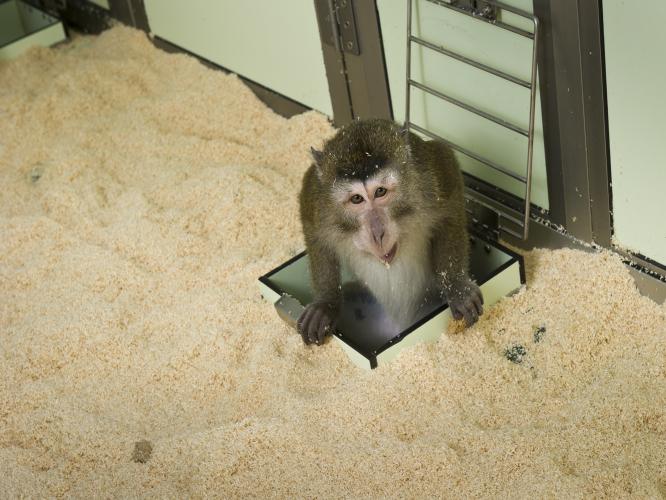 Cynomolgus macaque using hatch to enter play pen
Cynomolgus macaque using hatch to enter play pen -
 plastic objects joined together to create a climbing frame, positioned in the bay window
plastic objects joined together to create a climbing frame, positioned in the bay window -
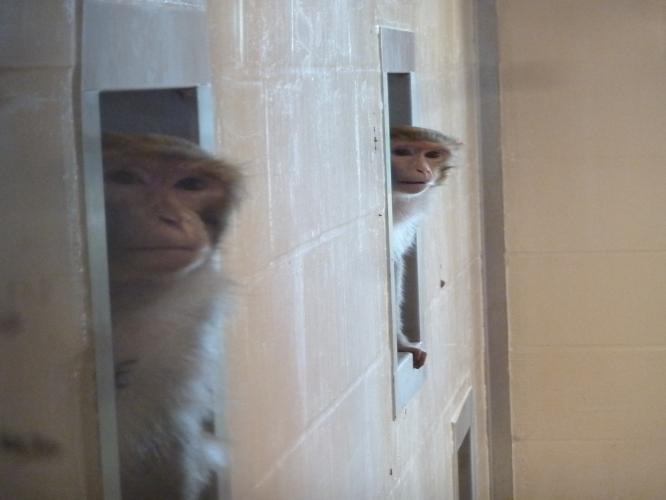 Rhesus macaques using the hatch doors between large room and adjoining caged area
Rhesus macaques using the hatch doors between large room and adjoining caged area -
A indoor room showing multiple hatches.
In the images above you can see:
- Macaques with access to a large room above their conventional caging below, via a pop hole.
- Staff-controlled hatches into an adjacent caging area which can be open and closed as required for husbandry purposes.
- Internal windows allowing the monkeys to view passing staff and macaques in the rooms opposite, providing additional visual stimulation.
- Rhesus macaques using the hatch doors between a large room and adjoining caged area.
- Plastic objects joined together to create a climbing frame, positioned in the bay window.
Considerations
- Where rooms are used as housing, they should be spacious to allow a full range of natural behaviours.
- The room needs to be made safe for both staff and animals with respect to electrical outlets, lights, drain holes and pipes.
- The ceiling and walls must be strong enough to support sturdy hooks and environmental enrichment fixings. Macaques will run, leap and jump on fittings and these stressors need to be taken into consideration at the design stage.
- Windows are needed for good observation of the animals. There should be adequate barriers for preventing escape.
- Ideally there should be access to an outdoor area or natural light.
- Avoid drainage systems which could become easily clogged.
- Husbandry practices need to be adapted to fit this style of animal management. There are specific staff training needs, as staff members must feel confident and relaxed working closely with macaques in a free environment. The best option is to use animals of defined health status (e.g. free of Herpes B virus).
Perceived problems and how to overcome them
Good habituation and socialisation to humans can overcome such problems.
Animal training using clear signals (see Habituation and training) and a series of staff-controlled hatches into adjacent caged areas (or between upper and lower levels) means animals may be separated with ease.
This type of husbandry system actually remains cleaner for longer, saving on cleaning time and releasing staff to spend more time on activities, such as positive reinforcement training for the animals.
This is easily prevented by the use of removable drain baskets (see Cleaning).
Wooden objects can be autoclaved and replaced regularly. Wooden objects may not differ from plastic toys with respect to the overall efficiency of cage-wash sanitisation [13]. Wood is chewed but not usually ingested, and reports of blockage of the gastrointestinal tract are rare – faeces can be monitored if ingestion is a concern.
Annotated tour
Take our annotated tour of a modern, high quality caging system which helps to support good animal welfare.
Aspects of best practice
- Flexible enclosure design with moveable panels allows the space to be divided to temporarily separate individuals or groups of animals. or to combine adjacent enclosures to allow additional space or house larger groups. Plastic panels are easily cleaned and lighter than Trespa® or wood.
- The room is utilised from floor to ceiling, making good use of the available space; high perches/platforms enable the monkeys to flee upwards when alarmed.
- Broad-spectrum lighting, rather than fluorescent strip lighting, which has a more positive effect on the health and behaviour of captive monkeys in indoor housing. Dimming at lights-on and -off stimulates dawn and dusk.
- Visual barriers provide privacy and refuge. Multiple escape routes permit hierarchical species such as macaques to manage their social interactions.
- Social housing in medium-sized, stable social groups with visual and auditory access to neighbouring groups allows a range of natural behaviours.
- Bay fronts to the enclosure, verandas and windows enable the monkeys to observe, and become accustomed to, human activity. These have the added advantage of enabling care staff to observe uninterrupted behaviour patterns.
- Varied climbing structures and other enrichment devices provide choice and complexity.
- Wind-up squeeze back mechanism (upper and lower enclosure) gives greater control for human and animal safety.
- Use of hardwood, which is warmer than metal, non-slip and can be chewed, providing some stimulation and control.
- Solid floor with substrate, into which seeds, grains, mealworms and other food items may be thrown provides extended foraging opportunities.
- Multiple resources such as shelves/resting areas, feeders and water spouts are provided in each enclosure to allow all animals to gain access and prevent dominant animals from monopolising them.
- Ample space for environmental enrichment items, such as swings and ropes, for exercise and natural behaviours.
- The horizontal bars on the enclosure fronts give better visibility down the room than do vertical bars, facilitate human-animal interaction and can be used for climbing.
- Socially housed animals provide research opportunities for scientific programmes incorporating social aspects.
Considerations
- Where caging is used as housing, the cage should be spacious to allow a full range of natural behaviours.
- When utilising the full height of the room, make sure the animals cannot access the lights in the ceiling. A gridded enclosure roof will maximises light and also allow suspension of enrichment items.
- Dirty substrate and organic waste matter need to be removed from the cage; wet cleaning is facilitated by a sloped floor running to a central drain, with removable basket to avoid blockages.
Perceived problems and how to overcome them
Animal training using clear signals (see the Habituation and training tab, under Husbandry) and a flexible enclosure design which removable panels, means animals may be separated with ease.
This type of husbandry system actually remains clearer for longer, saving on cleaning time and releasing staff to spend more time on activities, such as positive reinforcement training for the animals.
This is easily prevented by the use of removable drain baskets (see the Cleaning tab, under Husbandry).
Wooden objects can be autoclaved and replaced regularly. Wooden objects may not differ from plastic toys with respect to the overall efficiency of cage-wash sanitisation [13]. Wood is chewed but not usually ingested, and reports of gastrointestinal problems are rare – faeces can be monitored if ingestion is a concern.
Small, restrictive cages limit both the types of locomotion the animals are able to perform and the amount of physical exercise possible, which can lead to atrophy of muscles and decreased joint mobility [14,15]. The prevalence of stereotypes and other abnormal behaviours may also be higher in small enclosures than in larger, more complex ones.
Quality of space is also important, since even large enclosures can be of limited value to the animals if they are unable to make use of the space available. If spacious, modern housing systems cannot be provided (see Indoor caging), then ways of increasing the space and complexity in conventional caging should always be explored as an interim measure [5]. Consulting other facilities that have already adapted their caging will help with troubleshooting to avoid problems and maximise success.
In the image above you can see conventional stainless steel caging in a BSL3 facility which has been improved by the addition of high perches, dividers to adjoin adjacent cage units, and a solid floor with substrate for foraging. Note the cages use the full height of the room (Image credit: Karolina Westlund).
Providing an exercise and play area
Additional space and complexity can be provided to macaques housed in banks of conventional, steel caging by adjoining a purpose-built play area constructed cheaply using sturdy wood and thick mesh. This is a practical, cost-effective way of giving the animals greater opportunities for exercise and expression of natural behaviours.
Macaques can be provided with continuous or rotational access to the play area. Animals should be monitored to ensure that they use the space provided and do not remain in one part of the enclosure; if this happens, then changes to the enclosure or the home cage may need to be made.
Wood and mesh play area
-
Exercise play area to compliment conventional caging structures
Converting individual units to ‘gang caging’
Many establishments have successfully converted standard, metal cages into linked ‘gang caging’ simply by removing the partitions between adjacent and tiered units. Tunnels can also be used to link adjacent or neighbouring cages. These are simple, cost effective means of moving away from single housing. A flexible design of gang cage allows different sized groups of animals to be maintained together in a larger communal space. This type of caging has been used successfully in regulatory toxicology studies [6,16].
In contract research organisations in Europe, the gang caging system has generally been accepted and approved by client companies. Clients appreciate the benefits to both animals and science of the improved environment and the extended range of behaviours this allows. Very little concern has been expressed that the gang caging system could compromise regulatory studies, and no studies carried out in such housing have been rejected by regulatory agencies.
-
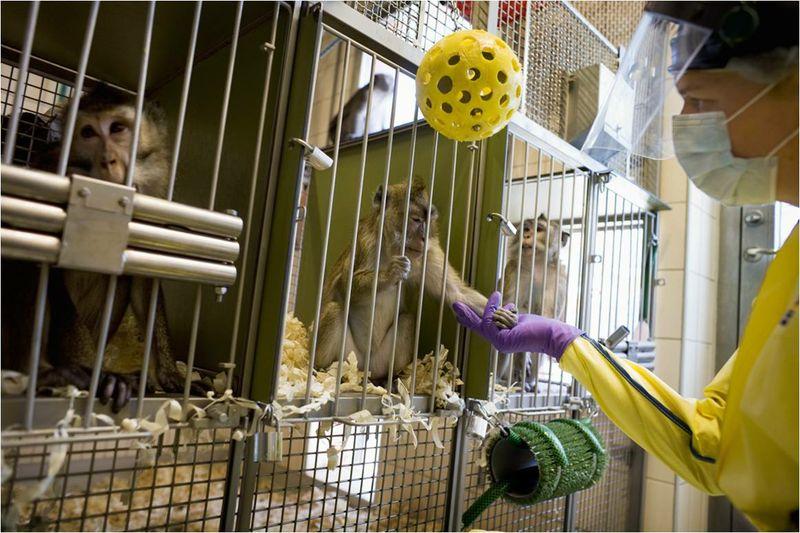 This caging has been linked together and opened up so that the macaques can access all cages (plus an outside space). Solid cage sides provide visual barriers helping to reduce aggression.
This caging has been linked together and opened up so that the macaques can access all cages (plus an outside space). Solid cage sides provide visual barriers helping to reduce aggression.
Perceived problems and how to overcome them
Quantitative measurement of individual food/water consumption is not possible in social groups, but the reliability of this measure is, in any case, questionable since singly housed macaques often scatter and waste their rations. Individual food consumption data are not routinely needed in toxicity testing; observing eating/drinking habits and monitoring body weight should suffice for identifying treatment effects. Alternatively, animals may be housed in pairs or groups and whole cage data presented.
Behavioural signs (e.g. changes in locomotion, balance, coordination, and peer interaction) are often easier to detect when macaques are housed in a social group because they express a wider range of natural behaviours than do singly housed animals. Any deterioration in well-being shows a marked contrast against both the behaviours of cage mates and the previous behaviours of the affected animals. Monitoring several animals in a social group simultaneously is also more time effective. If specifically concerned about vomiting, it is possible to temporarily individually house members of the social group (e.g. 1-2 hours) within sight and sound of each other.
Training animals to cooperate can overcome this problem (see Habituation and training).
Conflicts can arise between individuals. It is important to recognise the net welfare benefit of social housing and to minimise the risk of fights (see Social).
Adding a solid floor
Grid or slatted floors are uncomfortable for the animals and seriously limit provision of substrate. The insertion of a solid floor (by welding this into mobile units, or sealing the floor of a room) enables deep substrate to be provided (e.g. soft wood shavings) into which food items can be scattered; this occupies the animals for extended periods and helps promote calm behaviour. If a full solid floor is not possible (e.g. in a metabolism cage), a solid resting area (e.g. platform) should be provided with a foraging tray.
-
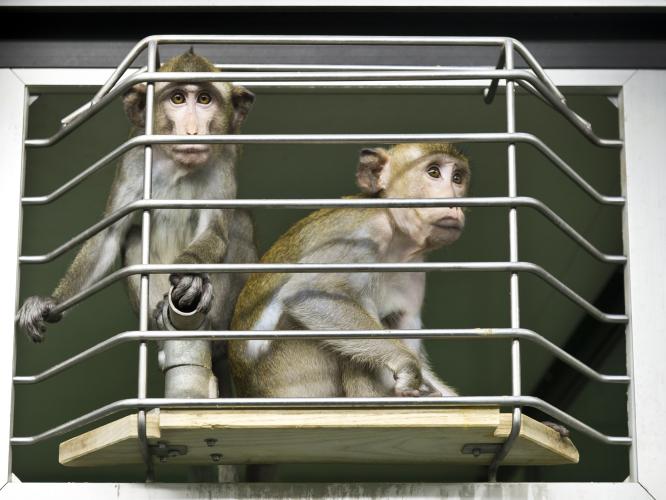 Monkeys perching on veranda in cage, it is good for there to be space for two monkeys to rest on the veranda.
Monkeys perching on veranda in cage, it is good for there to be space for two monkeys to rest on the veranda. -
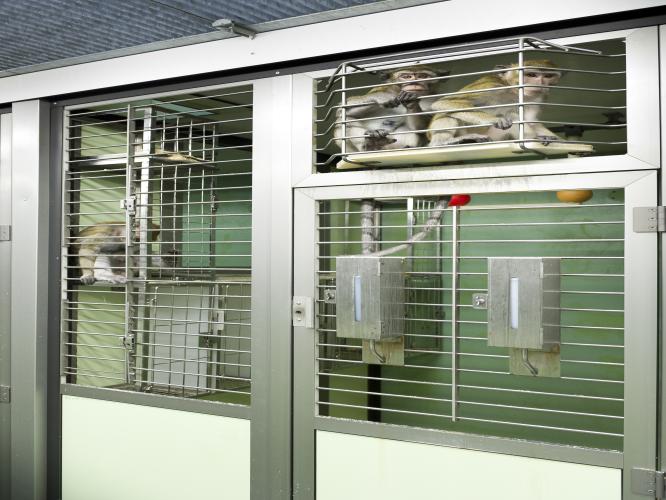 Verandas in cage, verandas positioned high on the cage front are well liked by macaques.
Verandas in cage, verandas positioned high on the cage front are well liked by macaques. -
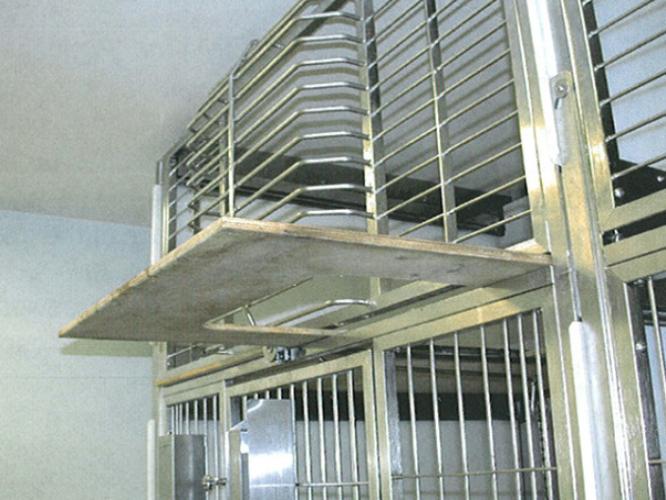 Cage extensions - you can utilise the full room height by adding extensions to the cage roof.
Cage extensions - you can utilise the full room height by adding extensions to the cage roof. -
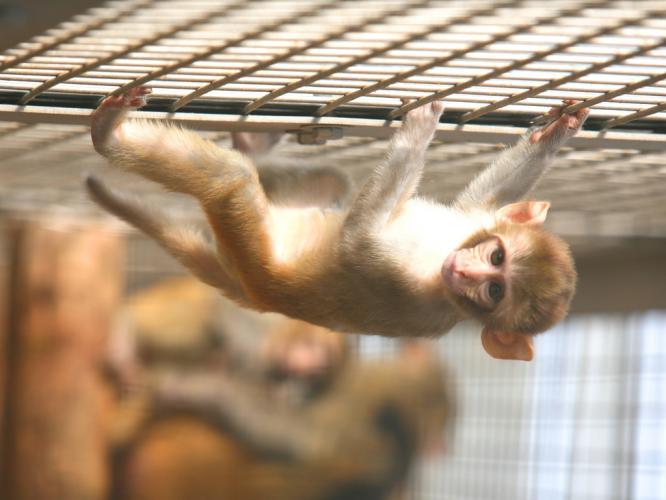 Rhesus macaque infant using mesh ceiling
Rhesus macaque infant using mesh ceiling
Incorporating cage extensions
Verandas and bow fronts, with or without solid flooring, can be attached to conventional caging to allow macaques greater lateral visibility of the holding room and other pens. This can help habituate them to human activity [6]. Ensuring verandas are not positioned to closely together, and/or visual barriers provided, will help prevent aggression between adjacent groups. Roof extensions to caging can also provide animals with additional space and visibility of the room.
Including cage furniture
If there is sufficient space, a wide selection of fixed, suspended and hanging objects give the animals items to move on and use (including to huddle and groom), and thus help provide the stimulation they need. Platforms and perches can be accommodated in most sizes of cage.
Fitting stainless steel mesh or bars to the solid sides and/or ceiling of cages will increase the available climbing opportunities. This also increases the opportunity to suspend enrichment items.
Macaques benefit from material that they can manipulate and destroy (e.g. cardboard boxes and hemp sacks) as this allows them some control over their environment by providing an element that they can change. Novel materials may be perceived to be a problem with respect to ease of cleaning or potential effects on scientific data (e.g. potential induction of liver enzymes by wood). Nevertheless, various materials have been used successfully, even in regulatory studies.
Visual barriers between and/or within enclosures allow the occupants the choice between seeing other macaques and humans, or hiding from them. This enables them to have greater control over their social interactions, helps minimize intra and inter-group aggression and promotes successful pairing and grouping [17-19]. Examples of visual barriers are floor mounted or hanging plastic panels, sacking or large wide pipes or barrels. They should be carefully positioned so that they do not block light sources.
Adapting enclosure materials
Wood is less cold and noisy than metal, provides a softer textured surface and facilitates a variety of species-typical behaviours, as it can be manipulated and chewed. Natural branches and/or wooden perches can be included to provide additional usable space. The type of wood must not be toxic to the animals; maple, beech and oak are all safe. If real wood cannot be used, then plastic is a good alternative.
-
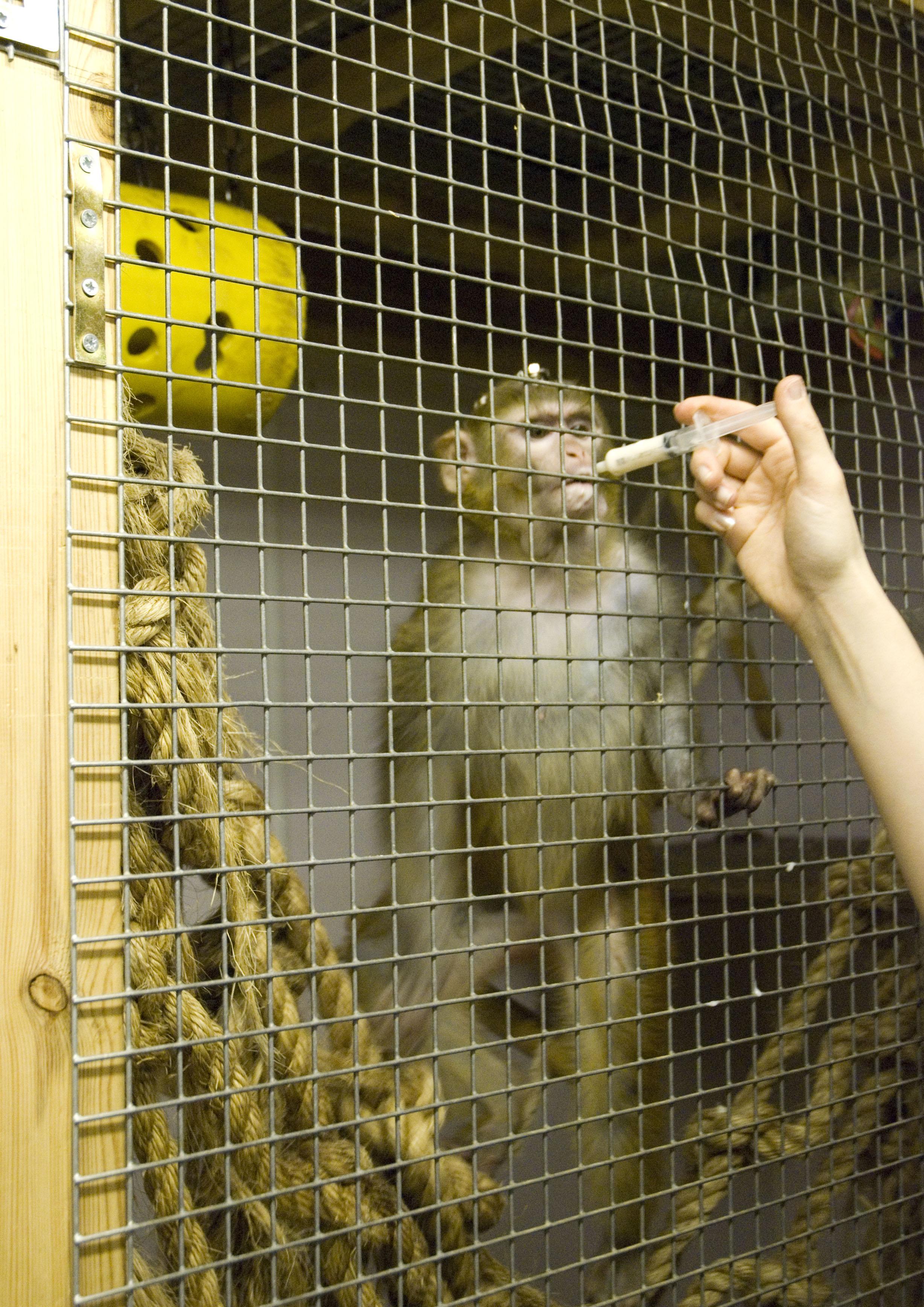 Wood and mesh enclosure provides a softer, warmer and less noisy environment.
Wood and mesh enclosure provides a softer, warmer and less noisy environment. -
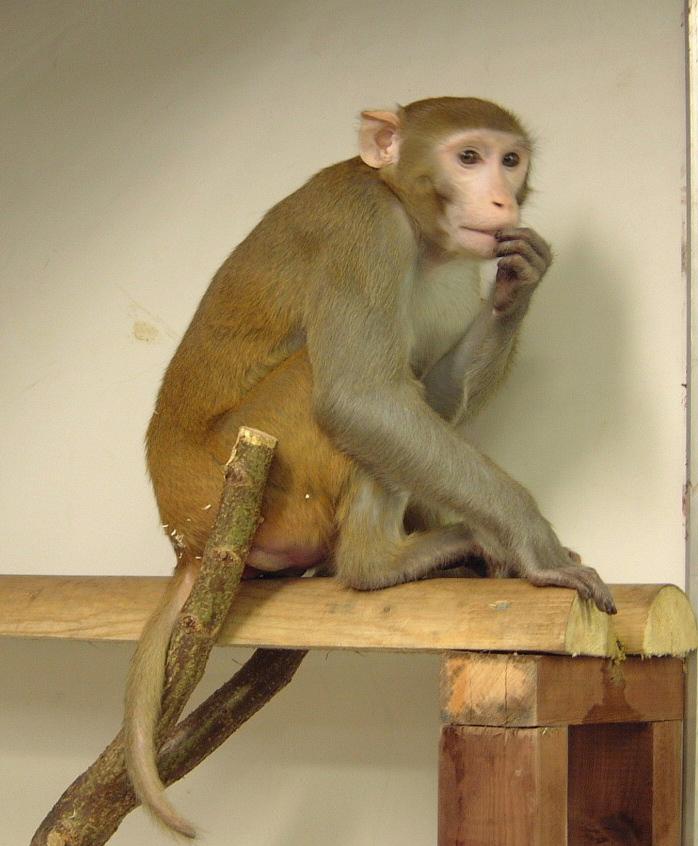 Natural branches and wooden perches can be used on most types of study,
Natural branches and wooden perches can be used on most types of study,
Staff safety is the primary consideration in studies involving macaques infected with dangerous pathogens and is assessed by a hierarchy of options:
- Removing the hazard – is the work necessary? (e.g. could a less dangerous species, a surrogate, or a less dangerous pathogen be used?).
- Isolating the hazard by primary containment (e.g. totally enclosed cabinets, plastic film isolators, individually ventilated cages).
- Partially isolating the hazard (e.g. by a combination of strategies, such as a directional flow system, transfer boxes, downdraught tables, personal protective equipment and respiratory protective equipment).
- Isolating the individual operator from the hazard (e.g. full airsuits or ventilated two-piece suits, such as Martindales).
- Staff vaccination.
Animal welfare is also an important consideration, for scientific and ethical reasons. Public Health England (PHE) has developed a state-of-the-art containment system which balances the need for staff safety at all stages of the experimental process, whilst addressing the requirements of macaques for space, environmental enrichment and social interaction. The system has been used in a series of studies involving biocontainment level 3 infectious agents (BCL3), such as Mycobacterium tuberculosis, Bacillus anthracis, Burkholderia pseudomallei and monkeypox virus administered by aerosol challenge (the most hazardous route). It allows group housing whilst offering quantifiable operator protection during infection, husbandry, experimental sampling and necropsy. The general principles for refinement can be modified to apply to BCL4 agents.
-
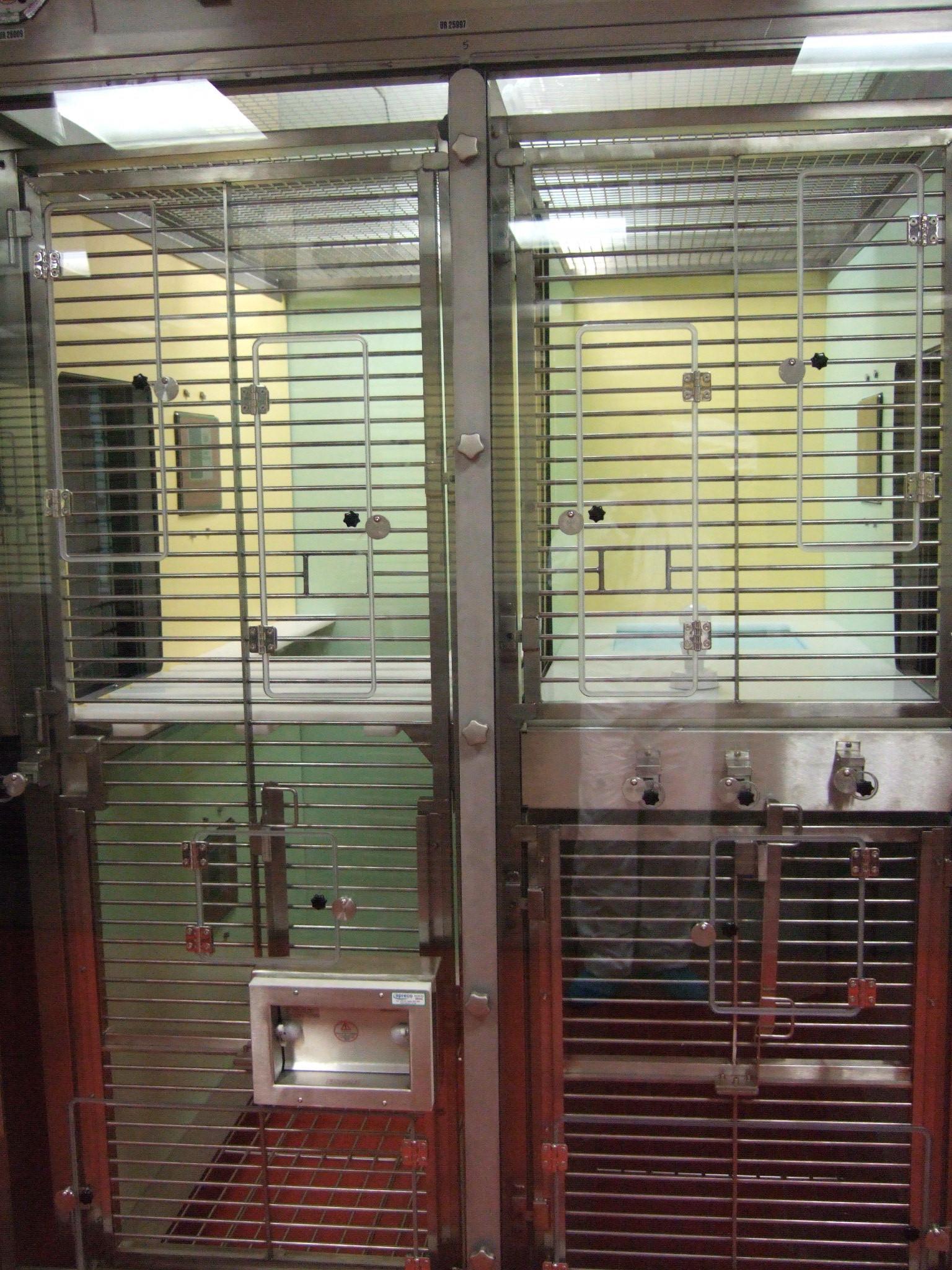 Containment system with three joined units (Image: Mike Dennis)
Containment system with three joined units (Image: Mike Dennis)
Containment system
The containment system utilises the principle of directional airflow away from the operator towards the back of the cage system in order to protect staff. A series of interconnected cages are placed inside modular booths that have a clear rigid plastic screen at the front of the system. This screen allows good observation of the macaques within the cages whilst providing protection from physical contamination by urination, defecation, cough, throwing of objects or by reaching through from the cage.
Each screen is fitted with flap valves that control the velocity of the air into the system and each has a number of small access doors placed in strategic alignment with the cage front to allow animal care staff access to replace food and water, change bedding and sedate the occupants for subsequent procedures. The number of airborne organisms is reduced by using this directional airflow away from the operator towards the rear of the cage. With correct operation this flow is maintained at a minimum of 0.7M/second and the air removed from the rear of the cage is extracted by a total-loss room air handling system via HEPA filtration. Further operator protection is provided by using a transfer box for sedated animals and a downdraught table for more risky procedures, such as blood sampling, broncheoalveolar lavage, X-rays, close clinical assessment and necropsy.
Animal welfare needs are provided for by incorporating group housing and pre-training into the study design (see below), utilising full height cages that meet the standards of Directive 2010/63/EU and Appendix A to Convention ETS 123, and providing foraging enrichment and toys such as balls, wooden dumbbells, chains and mirrors.
Cages used for studies involving infectious agents need to be able to withstand robust decontamination processes, such as autoclaving and fumigation, that are required at the end of a study to provide for staff safety and for the scientific integrity of the following study. Whilst stainless steel is the obvious choice as a material for such cages, other materials can be used to provide a softer and less noisy environment, such as Trespa® for cage partitions and polypropylene for platforms, shelves and perches.
Group housing
Group housing has been used without problems in terms of cross-infection, provided that all animals housed in each group receive the same treatment, such as the infectious dose and/or vaccination regime. Vaccinated and naïve animals are not housed together where a live vaccine such as BCG or a vaccine using a live viral vector is being used, as the close association of cage mates could bring about immune stimulation of the unvaccinated animals and compromise the results of the experiment. Compatible groups of up to six macaques have been housed together successfully with no confounding effect on the experimental outcomes.
-
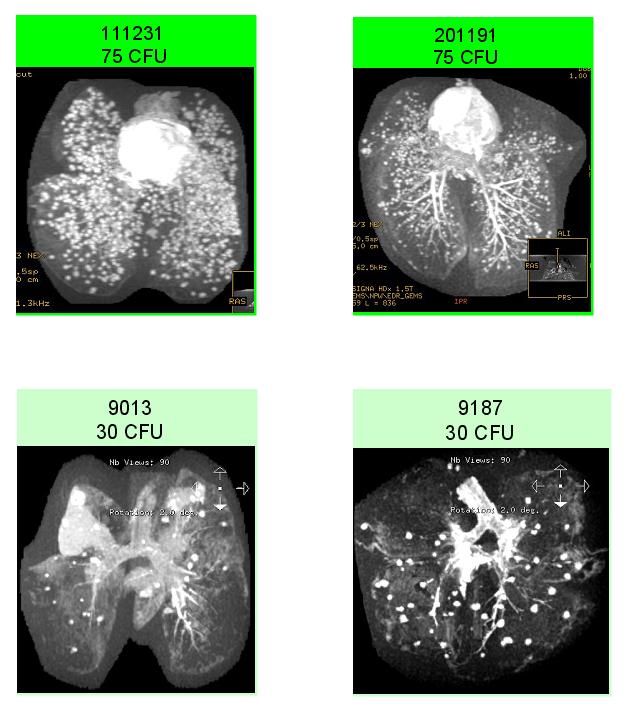 MRI scans of the lungs of unvaccinated animals (two per dose level) given two different doses – 75 colony forming units (CFU) or 30 CFU – of the bacterium M. tuberculosis. It can be seen that the two animals housed together show the same level of disease
MRI scans of the lungs of unvaccinated animals (two per dose level) given two different doses – 75 colony forming units (CFU) or 30 CFU – of the bacterium M. tuberculosis. It can be seen that the two animals housed together show the same level of disease
In the image above, it can be seen that the two animals housed together show the same level of disease pathology and that this is dependent upon the initial dose given rather than any cross-infection.
Pre-training and acclimatisation
When working with dangerous pathogens, physically restraining macaques to administer substances by gavage is not a safe option, and where significant volumes of blood are required it would be difficult to sample safely from an unsedated individual. What can be achieved, however, is training of the animals to take an oral dose of, for example, an antibiotic. Typically macaques at PHE are trained using positive reinforcement techniques to: i) station (move to a specific location in their home cage) so that all individuals can be effectively dosed without interference; and ii) co-operate by presenting themselves for intramuscular injection of a sedative, so that procedures such as X-ray, weighing and temperature measurement, which are vital to clinical assessment, can be conducted safely and with minimal stress caused to the animals. Staff members, including researchers, are actively encouraged to interact with macaques before the infection phase of an experiment in order to familiarise the animals with the presence and behaviour of humans. Training the animals to receive an oral dose, to remain stationed whilst others receive theirs, and to come forward for injection is now an integral part of the experimental protocol. It is considered that this will lead to scientific benefit in terms of the reproducibility of results.
Due consideration is also given to the changes to the macaques’ environment that will occur once infectious challenge has taken place. For example, the animals can be acclimatised to changes in the appearance of staff wearing protective clothing, for short periods before challenge. Similarly, the animals can be introduced to containment housing prior to challenge so that they acclimatise to this novel environment. Some establishments do this by placing open cages within a larger gang pen set up, so that animals grow used to the cages, can enter and leave them at will and can use them as a refuge or feeding station.
-
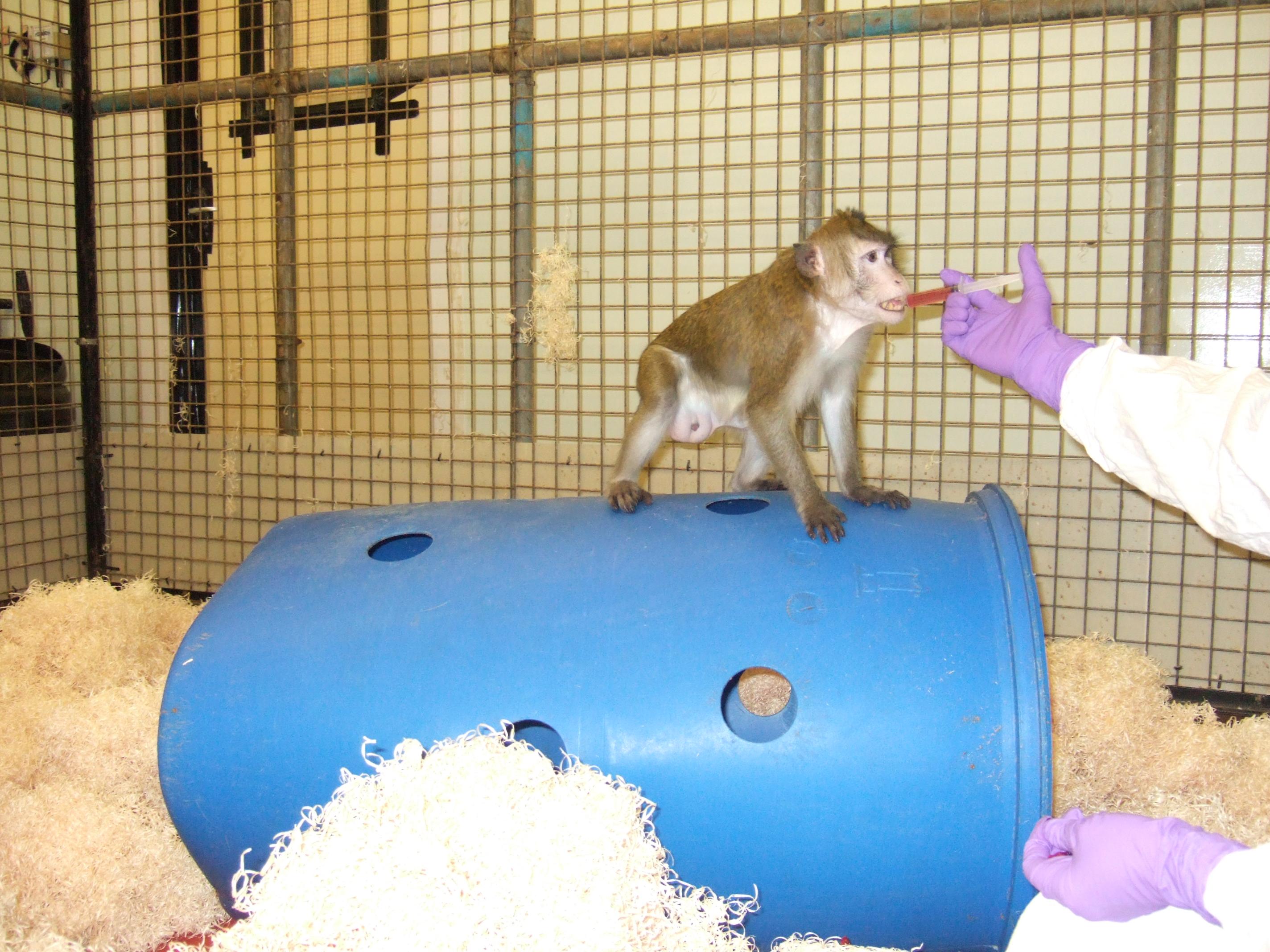 Training for dosing
Training for dosing -
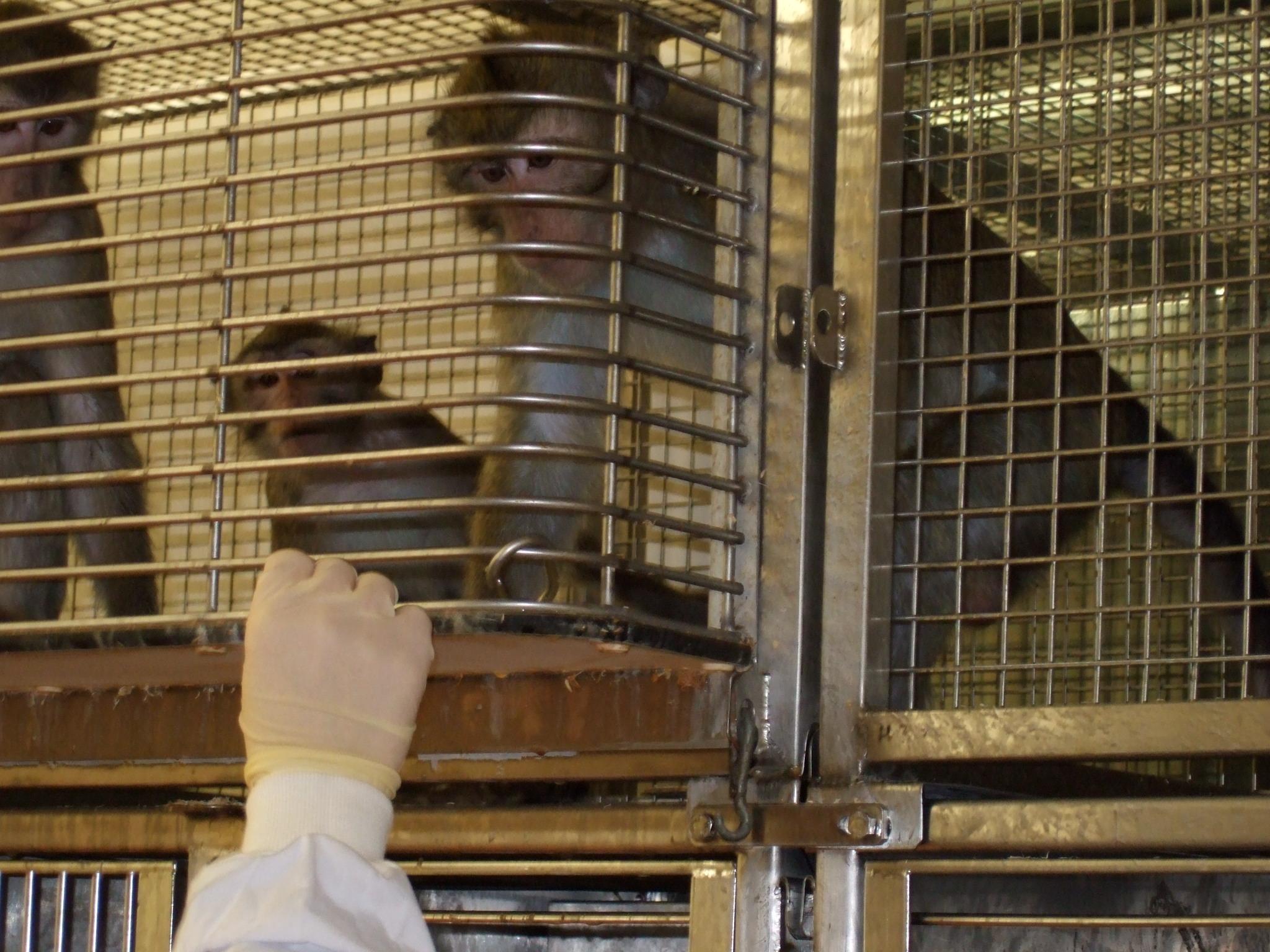 Training for stationing (Image: Mike Dennis)
Training for stationing (Image: Mike Dennis)
Environmental enrichment
When using some pathogens, it is not good containment practice to allow animals to have direct contact with floor substrate. However, a grid floor can be provided above a tray containing substrate such as Enviro-dri® or SizzleNest® to allow foraging behaviour. Alternatively, or additionally, puzzle feeders and forage boxes can be placed within the cage where they do not obstruct any dividing or restraining mechanisms. Forage boxes can be made of cheap, simple disposable materials, such as cardboard. PHE has also demonstrated that the environment within biocontainment can be effectively enriched via the use of ropes/rope ladders or by hanging high value food items within suitable containers hung from chains. Such items increase the complexity of the cage environment and the opportunities for interactive behaviour.
Whilst items such as rope and plastic feeders or balls placed within the cage environment have the potential to become contaminated with the infectious agent, this has not caused issues with the outcome of studies at PHE. Some items may be robust enough to withstand decontamination by autoclaving, but it is considered better practice to dispose of such items at the end of each study after making them safe by the most suitable method.
-
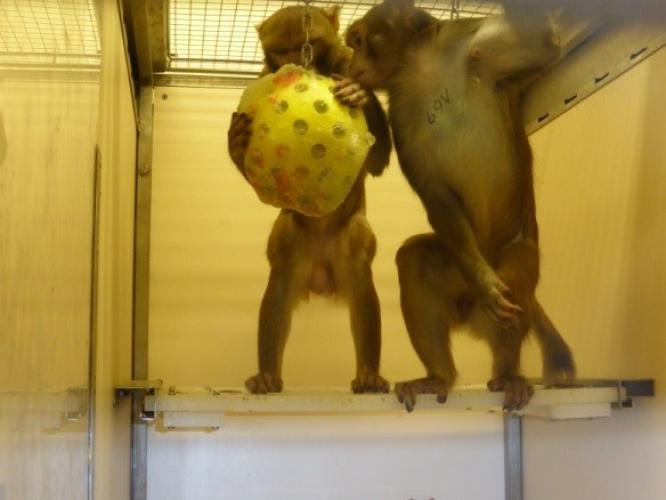 Puzzle ball (Image: Public Health England)
Puzzle ball (Image: Public Health England) -
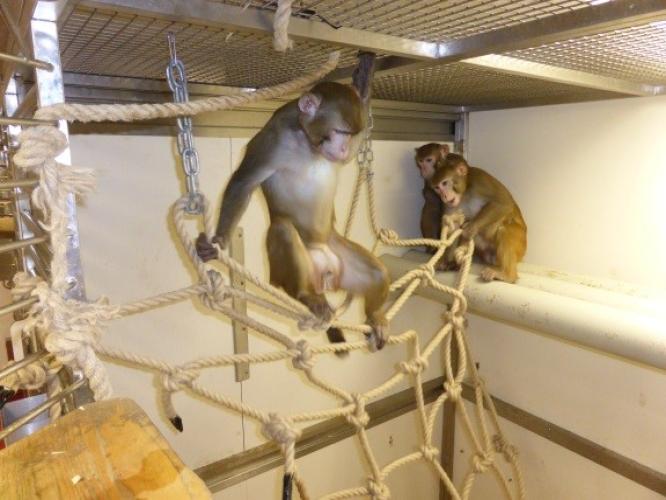 Rope ladder (Image: Public Health England)
Rope ladder (Image: Public Health England) -
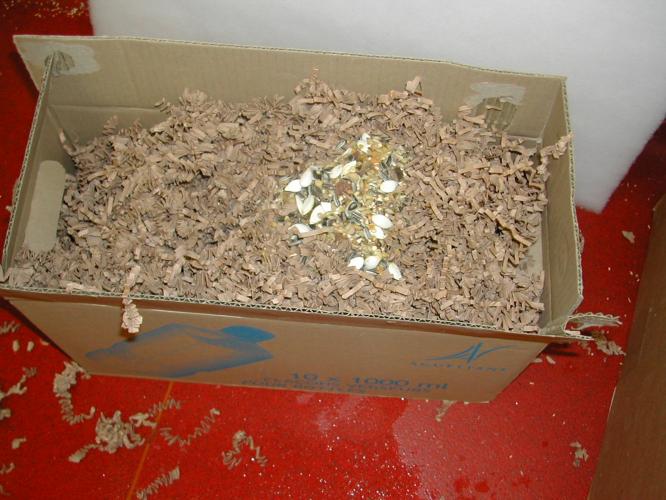 Forage box (Image: Mike Dennis)
Forage box (Image: Mike Dennis) -
 Puzzle feeder
Puzzle feeder
Control
When using highly infectious agents, the risks associated with the husbandry and experimental handling of non-human primates must be controlled by strict discipline with regard to feeding, watering and waste removal regimes. For these activities staff members are trained to adhere to a protocol described in a code of practice.
he setting of robust, early experimental end points, using a range of clinical and behavioural parameters or microbiological indicators, minimises animal suffering and reduces risk to staff. For example, a read-out end point for protection or efficacy could be virus isolation or viral load by polymerase chain reaction (PCR) in untreated controls before onset of disease (pilot experiments may be required to verify that this, combined with other clinical parameters, correlates with progression to disease). This is obviously better from both an animal welfare and staff safety point of view rather than allowing progression to severe disease. This is an area where there is a strong case for data sharing on national and international levels, so that research groups can learn from previous work and not repeat experiments to establish such end-points. Clinical monitoring can be carried out by taking X-rays, or more advanced imaging such as computed tomography [20] or Magnetic Resonance scanning [21], and by using telemetry implants to monitor heart rate, blood pressure, temperature, activity and respiration rate. Previously, telemetry systems available required the macaques to be separated during data capture to avoid cross talk interference that may render the data meaningless, although they could be housed with non-implanted companions. However, telemetry systems have now been developed that allow simultaneous data capture from telemetered group-housed animals. In order to monitor animals for the onset of clinical signs there needs to be a commitment to round-the-clock monitoring for infected animals. This may mean that staff members need to enter the animal room on a regular basis throughout the night or, alternatively, observation can be made using closed circuit television (CCTV). It has been found that this is not only more convenient for staff but also is less disruptive for the animals. Furthermore, clinical assessment of animals that have been disturbed by the entry of an observer can be far less informative than remote observation of animals unaware of, and not stimulated by, the presence of humans.
-
 CCTV observation (Image: Mike Dennis)
CCTV observation (Image: Mike Dennis) -
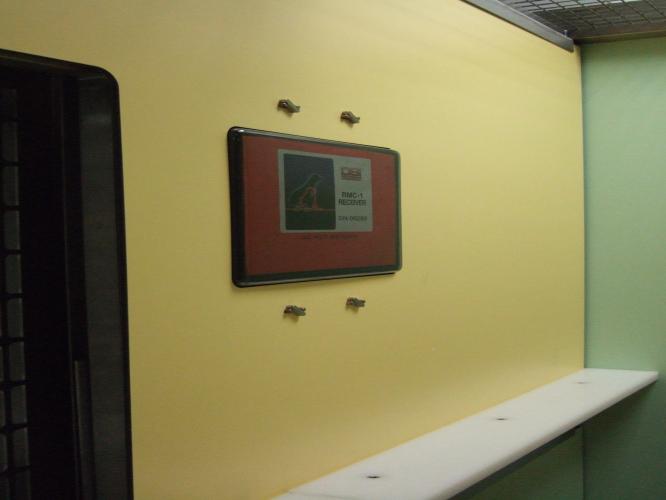 Telemetry receiver (Image: Mike Dennis)
Telemetry receiver (Image: Mike Dennis) -
 Taking an X-ray under containment. (Image: Mike Dennis)
Taking an X-ray under containment. (Image: Mike Dennis)
References
- Buchanan-Smith HM et al. (2004). What factors should determine cage sizes for primates in the laboratory? Animal Welfare 13: 197-201.
-
Reinhardt V and Reinhardt A (2002). Comfortable quarters for primates in research institutions. Animal Welfare Institute.
-
Reinhardt V (2004). Common husbandry-related variables in biomedical research with animals. Laboratory Animals 38(3): 213-35. https://doi.org/10.1258/002367704323133600
-
Rennie AE and Buchanan-Smith HM (2006). Refinement of the use of non-human primates in scientific research. Part ii: Housing, husbandry and acquisition. Animal Welfare. https://www.researchgate.net/publication/228670741
-
Jennings M et al. (2009). Refinements in husbandry, care and common procedures for non-human primates. Laboratory Animals 43(1_suppl): 1-47. https://doi.org/10.1258/la.2008.007143
-
Frost S (2004). Huntingdon life sciences - old world primate cage replacement. Animal Technology and Welfare 3(3): 185-187 3(3): 185-7.
-
Reinhardt V and Reinhardt A (2002). Comfortable quarters for primates in research institutions. Animal Welfare Institute.
-
Beisner BA and Isbell LA (2008). Ground substrate affects activity budgets and hair loss in outdoor captive groups of rhesus macaques (macaca mulatta). American Journal of Primatology 70(12): 1160-8. https://doi.org/10.1002/ajp.20615
-
Beisner BA and Isbell LA (2011). Factors affecting aggression among females in captive groups of rhesus macaques (macaca mulatta). American Journal of Primatology 73(11): 1152-9. https://doi.org/10.1002/ajp.20982
-
Baumans V et al. (2007). Making lives easier for animals in research labs. Animal Welfare Institute.
-
Lynch R and Baker D (1998). Enrichment and exercise room for free roaming. Laboratory Primate Newsletter 37(1): 6-7.
-
Wolfensohn S (2004). Social housing of large primates: Methodology for refinement of husbandry and management. Alternatives to Laboratory Animals 32(1_suppl): 149-51. https://doi.org/10.1177/026119290403201s24
-
Luchins KR et al. (2011). Manzanita wood: A sanitizable enrichment option for nonhuman primates. Journal of the American Association for Laboratory Animal Science 50(6): 884-7.
-
Faucheux B et al. (1978). Some effects of living conditions upon the pattern of growth in the stumptail macaque (macaca arctoides). Folia Primatologica 30(3): 220-36. https://doi.org/10.1159/000155865
-
Turnquist JE (1985). Passive joint mobility in patas monkeys (erythrocebus patas): Rehabilitation of caged animals after release into a free-ranging environment. American Journal of Physical Anthropology 67(1): 1-5. https://doi.org/10.1002/ajpa.1330670102
-
Chapman K et al. (2015). Opportunities for implementing the 3 rs in drug development and safety assessment studies using nonhuman primates. In: The nonhuman primate in nonclinical drug development and safety assessment (Eds. Bluemel J, Korte S, Schneck E, and Weinbauer GF) (pp. 281-301). Academic Press. https://doi.org/10.1016/B978-0-12-417144-2.00014-7
-
Goosen C et al. (1984). Recommendations for the housing of macaque monkeys. Laboratory Animals 18(2): 99-102. https://doi.org/10.1258/002367784780891316
-
McKenzie SM et al. (1986). Floor-coverings and hanging screens alter arboreal monkey behavior. Zoo Biology 5(4): 339-48. https://doi.org/10.1002/zoo.1430050404
-
Watts E and Meder A (1996). Introduction and socialization techniques for primates. In: Wild mammals in captivity: Principles and techniques (Eds. Kleiman DG, Allen ME, Lumpkin S, Thompson KV, and Harrish H) (pp. 67-77). University of Chicago Press.
-
Sharpe SA et al. (2018). Refinement and reduction through application of a quantitative score system for estimation of tb-induced disease burden using computed tomography. Laboratory Animals 52(6): 599-610. https://doi.org/10.1177/0023677218757815
-
Dennis MJ et al. (2015). A flexible approach to imaging in absl-3 laboratories. Applied Biosafety 20(2): 89-99. https://doi.org/10.1177/153567601502000204




